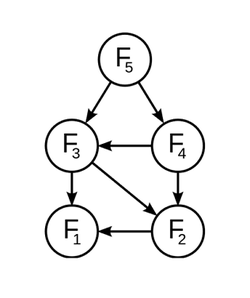Fibonacci Power!
 How many values of
k
are there such that
F
k
is of the form
2
n
?
How many values of
k
are there such that
F
k
is of the form
2
n
?
Note that both k and n are non-negative integers.
Also F 0 = 0 , F 1 = 1 and F m = F m − 1 + F m − 2
The answer is 4.
This section requires Javascript.
You are seeing this because something didn't load right. We suggest you, (a) try
refreshing the page, (b) enabling javascript if it is disabled on your browser and,
finally, (c)
loading the
non-javascript version of this page
. We're sorry about the hassle.
3 solutions
Can you explain why the greatest power of 2 is 8 ?
I was inspired to make this problem when I stumbled across this paper .
Log in to reply
I linked it. Didn't you see?
Some parts of the paper went over my head. I've really got to pick up on number theory. But I skimmed through the paper and it seems very interesting.
It's definitely very exciting to say with certainty that only so and so many powers of 2 exist in an infinite sequence!
- for k ≤ 6 , it's easy to check that k = 1 , 2 , 3 , 6 satisfy the condition.
- for k > 6 , 6 ∣ k if F k is of the form 2 n .
Let k = 6 l . We get that F l and F 3 l are also of the form 2 n . Because 2 ∣ F l if and only if 3 ∣ l , 9 ∣ 3 l , so F 9 = 3 4 is also of the form 2 n . Contradict
I used Carmichael's theorem to find the number of solutions. I would love to see a direct approach for the problem.
Carmichael's theorem: For n greater than 1 2 , the n th Fibonacci number F n has at least one prime divisor that does not divide any earlier Fibonacci number.
Moderator note:
There is an approach that uses a less high-power theorem.
Hint: F m ∣ F n ⇔ m ∣ n
@Calvin Lin Can you please elaborate ?? I couldn't get you!!
Log in to reply
Assuming that theorem is true,
- (some work required ) Using F 6 = 8 , show that if F k = 2 n > 8 , then k = 6 m .
- Show that F 3 6 is not a power of 2. (This can be done without calculating F 3 6 ).
- Hence, conclude that there is no F k = 2 n > 8 .
Log in to reply
Although I couldn't reduce k exactly in the form 6 m , but something similar to it.
Like clearly as you said 6 ∣ k . So let k = 6 n .
If 2 ∣ n ⇒ 4 ∣ 6 n ⇒ F 4 ∣ F 6 n ⇒ F 4 = 2 a . But this is not true .
If 3 ∣ n ⇒ 9 ∣ 6 n ⇒ F 9 ∣ F 6 n ⇒ F 9 = 2 a . But this is not true .
If 5 ∣ n ⇒ 5 ∣ 6 n ⇒ F 5 ∣ F 6 n ⇒ F 5 = 2 a . But this is not true .
If p : p r i m e , p > 6 , p ∣ n ⇒ p ∣ 6 n ⇒ F p ∣ F 6 n ⇒ F p = 2 a ⇒ 6 ∣ p . But this is not true.
∴ n = 1 ⇒ k = 6 is the only possibility.
Please give suggestions and tell me whether I am right or not..!!
Log in to reply
@Ankit Kumar Jain – @Calvin Lin
I just got another idea , I could have even directly used the fact that F 2 , F 3 are powers to 2 , and using a similar analysis I could have reached the result.
Am I right enough?
I got the result that the greatest Fibonacci number that's a power of 2 is 8 from here . So that leaves F 1 = F 2 = 1 = 2 0 ; F 3 = 2 1 and F 6 = 8 = 2 3 .
That means exactly four powers of 2 in an infinite sequence! Wow!